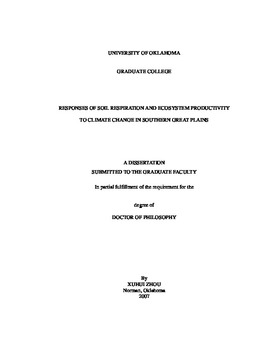| dc.contributor.advisor | Luo, Yiqi, | en_US |
| dc.contributor.author | Zhou, Xuhui. | en_US |
| dc.date.accessioned | 2013-08-16T12:20:36Z | |
| dc.date.available | 2013-08-16T12:20:36Z | |
| dc.date.issued | 2007 | en_US |
| dc.identifier.uri | https://hdl.handle.net/11244/1173 | |
| dc.description.abstract | The third is to investigate the role of precipitation on ecosystem carbon processes (i.e., biomass, litterfall, and soil respiration) along a natural precipitation gradient in southern Great Plains. Our results show that aboveground biomass (AGB), standing litter (ST), surface litter (SU), and soil respiration often linearly increased with an increase in precipitation along the gradient, although belowground biomass (BGB) and total biomass did not largely change. (Abstract shortened by UMI.) | en_US |
| dc.description.abstract | Terrestrial carbon processes, such as soil respiration and its components, net primary production (NPP), net ecosystem carbon exchange (NEE), and litterfall, are the important global change issues, which are related to carbon sequestration and ecosystem carbon-cycle feedback to climate change. This dissertation summarized four independent projects using experimental and modeling approaches. In the first study, I took advantage of two manipulative experiments---one long-term with a 2° C increase and yearly clipping (Experiment 1) and one short-term with a 4.4° C increase and doubled precipitation (Experiment 2)---to investigate main and interactive effects of warming, clipping, and doubled precipitation on soil respiration in a tallgrass prairie ecosystem. The transient responses to clipping were also studied in Experiment 2 (referred to as the transient study). On average, warming increased soil respiration by 13.0% ( p < 0.01) in Experiment 1, by 22.9% (p < 0.0001) in Experiment 2, and by 26.6% (p < 0.0001) in the transient study. Doubled precipitation resulted in an increase of 9.0% (p < 0.05) in soil respiration in Experiment 2. Yearly clipping did not significantly affect soil respiration (p = 0.66) in Experiment 1, while clipping decreased soil respiration by 16.1% (p < 0.05) in the transient study. No significant interactive effects among the experimental factors were statistically found on soil respiration or their temperature sensitivities except for the warmingxclipping interaction ( p < 0.05) in the transient study. The observed minor interactive effects relative to main ones suggest that results from single-factor experiments are useful in informing us of potential responses of soil respiration to multi-factor global change, at least in our ecosystem. | en_US |
| dc.description.abstract | In the second experiment, a long-term experiment was conducted to investigate effects of warming and yearly clipping on soil respiration and its components (autotrophic and heterotrophic respiration, RA and RH) in a tallgrass prairie ecosystem. Interannual variability of these fluxes was also examined. Using the deep-collar insertion to partition soil respiration, heterotrophic respiration accounted for approximately 66% of soil respiration over the six years. Warming treatment significantly stimulated soil respiration and its components (i.e., RA and RH) in most years. In contrast, yearly clipping significantly reduced soil respiration only in the last two years, although it decreased RH in every year of the study. Temperature sensitivity (i.e., apparent Q10 values) of soil respiration was slightly lower under warming (p>0.05) and reduced considerably by clipping (p< 0.05) compared to that in the control. However, warming did not change relative contributions of RA or RH to soil respiration. In addition, the apparent Q10 values for RA were higher than those for RH and soil respiration. Annual soil respiration did not vary substantially among years as precipitation did. The interannual variability of soil respiration may be mainly caused by precipitation distribution and summer severe drought. Our results suggest that the effects of warming and yearly clipping on soil respiration and its components did not result in significant changes in R H or RA contribution, and rainfall timing may be more important in determining interannual variability of soil respiration than the amount of annual precipitation. | en_US |
| dc.format.extent | xix, 165 leaves : | en_US |
| dc.subject | Climatic changes Great Plains. | en_US |
| dc.subject | Biology, Ecology. | en_US |
| dc.subject | Atmospheric Sciences. | en_US |
| dc.subject | Biogeochemistry. | en_US |
| dc.subject | Soil aeration. | en_US |
| dc.subject | Soil air. | en_US |
| dc.subject | Soils Carbon content Great Plains. | en_US |
| dc.subject | Biotic communities Great Plains. | en_US |
| dc.title | Responses of soil respiration and ecosystem productivity to climate change in southern Great Plains. | en_US |
| dc.type | Thesis | en_US |
| dc.thesis.degree | Ph.D. | en_US |
| dc.thesis.degreeDiscipline | Department of Microbiology and Plant Biology | en_US |
| dc.note | Adviser: Yiqi Luo. | en_US |
| dc.note | Source: Dissertation Abstracts International, Volume: 68-04, Section: B, page: 2040. | en_US |
| ou.identifier | (UMI)AAI3261096 | en_US |
| ou.group | College of Arts and Sciences::Department of Microbiology and Plant Biology | |
